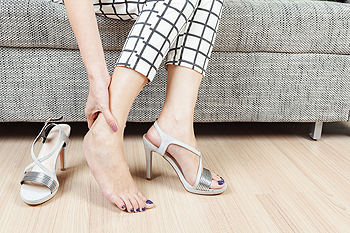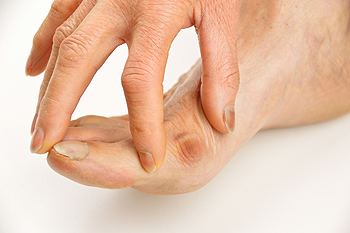
Drexel Hill (484) 521-0233
West Chester (610) 436-5883

Drexel Hill (484) 521-0233
West Chester (610) 436-5883
 Children and young teenagers who frequently participate in sporting activities may complain of heel pain. This may be indicative of a condition that is referred to as Sever’s disease which affects the growth plate in the heel. Sever’s disease can be a common ailment among gymnasts, and specific symptoms often accompany it. These can include swelling, pain, and difficulty walking. Mild relief may be found when the patient walks on tiptoes, and when the affected foot is elevated. The healing process can include performing certain foot stretches, and it may be beneficial to wear a protective boot. If your child has heel pain, please speak with a podiatrist, who can effectively treat Sever’s disease, as quickly as possible.
Children and young teenagers who frequently participate in sporting activities may complain of heel pain. This may be indicative of a condition that is referred to as Sever’s disease which affects the growth plate in the heel. Sever’s disease can be a common ailment among gymnasts, and specific symptoms often accompany it. These can include swelling, pain, and difficulty walking. Mild relief may be found when the patient walks on tiptoes, and when the affected foot is elevated. The healing process can include performing certain foot stretches, and it may be beneficial to wear a protective boot. If your child has heel pain, please speak with a podiatrist, who can effectively treat Sever’s disease, as quickly as possible.
Sever's disease often occurs in children and teens. If your child is experiencing foot or ankle pain, see the podiatrists from Dr. Siegerman & Associates. Our doctors can treat your child’s foot and ankle needs.
Sever’s Disease
Sever’s disease is also known as calcaneal apophysitis, which is a medical condition that causes heel pain I none or both feet. The disease is known to affect children between the ages of 8 and 14.
Sever’s disease occurs when part of the child’s heel known as the growth plate (calcaneal epiphysis) is attached to the Achilles tendon. This area can suffer injury when the muscles and tendons of the growing foot do not keep pace with bone growth. Therefore, the constant pain which one experiences at the back of the heel will make the child unable to put any weight on the heel. The child is then forced to walk on their toes.
Symptoms
Acute pain – Pain associated with Sever’s disease is usually felt in the heel when the child engages in physical activity such as walking, jumping and or running.
Highly active – Children who are very active are among the most susceptible in experiencing Sever’s disease, because of the stress and tension placed on their feet.
If you have any questions, please feel free to contact one of our offices located in Drexel Hill and West Chester, PA . We offer the newest diagnostic and treatment technologies for all your foot and ankle injuries.
 High heels have become notorious for creating issues with the feet. One common struggle many women face when choosing to wear high heels is that they often develop blisters on their toes or on the back of their heels. If the high heels you are wearing are slightly too big, it will cause friction with the skin of your feet, causing blisters to form. Blisters can be incredibly uncomfortable, and often painful, making it difficult to walk. Some women apply bandages to their heels or toes to limit the amount of friction between the shoes and skin. For more advice on how to prevent blisters while wearing high heels, please speak with a podiatrist.
High heels have become notorious for creating issues with the feet. One common struggle many women face when choosing to wear high heels is that they often develop blisters on their toes or on the back of their heels. If the high heels you are wearing are slightly too big, it will cause friction with the skin of your feet, causing blisters to form. Blisters can be incredibly uncomfortable, and often painful, making it difficult to walk. Some women apply bandages to their heels or toes to limit the amount of friction between the shoes and skin. For more advice on how to prevent blisters while wearing high heels, please speak with a podiatrist.
Blisters are prone to making everyday activities extremely uncomfortable. If your feet are hurting, contact the podiatrists of Dr. Siegerman & Associates. Our doctors can provide the care you need to keep you pain-free and on your feet.
Foot Blisters
Foot blisters develop as a result of constantly wearing tight or ill-fitting footwear. This happens due to the constant rubbing from the shoe, which can often lead to pain.
What Are Foot Blisters?
A foot blister is a small fluid-filled pocket that forms on the upper-most layer of the skin. Blisters are filled with clear fluid and can lead to blood drainage or pus if the area becomes infected.
How Do Blisters Form?
Blisters on the feet are often the result of constant friction of skin and material, usually by shoe rubbing. Walking in sandals, boots, or shoes that don’t fit properly for long periods of time can result in a blister. Having consistent foot moisture and humidity can easily lead to blister formation.
Prevention & Treatment
It is important to properly care for the affected area in order to prevent infection and ease the pain. Do not lance the blister and use a Band-Aid to provide pain relief. Also, be sure to keep your feet dry and wear proper fitting shoes. If you see blood or pus in a blister, seek assistance from a podiatrist.
If you have any questions, please feel free to contact one of our offices located in Drexel Hill and West Chester, PA . We offer the newest diagnostic and treatment technologies for all your foot care needs.
 Bunions that develop in young children are referred to as juvenile hallux valgus. They may exist as a result of genetic traits, or from wearing shoes that do not have adequate room for the toes to move freely in. Noticeable signs that your child may have a bunion can include a bony protrusion that forms on the side of the big toe, and red and swollen appearance. A proper diagnosis can consist of having an X-ray taken, as this may help to determine how severe the bunion is. When the bunion is identified at an early stage, it may be effective to use non-surgical techniques to obtain mild relief. These can include wearing shoes that have a wide toe area, or using custom-made insoles that may help to alleviate pressure. If your child has a bunion, it is strongly suggested that you seek the counsel of a podiatrist who can properly treat this condition.
Bunions that develop in young children are referred to as juvenile hallux valgus. They may exist as a result of genetic traits, or from wearing shoes that do not have adequate room for the toes to move freely in. Noticeable signs that your child may have a bunion can include a bony protrusion that forms on the side of the big toe, and red and swollen appearance. A proper diagnosis can consist of having an X-ray taken, as this may help to determine how severe the bunion is. When the bunion is identified at an early stage, it may be effective to use non-surgical techniques to obtain mild relief. These can include wearing shoes that have a wide toe area, or using custom-made insoles that may help to alleviate pressure. If your child has a bunion, it is strongly suggested that you seek the counsel of a podiatrist who can properly treat this condition.
If you are suffering from bunions, contact the podiatrists of Dr. Siegerman & Associates. Our doctors can provide the care you need to keep you pain-free and on your feet.
What Is a Bunion?
A bunion is formed of swollen tissue or an enlargement of boney growth, usually located at the base joint of the toe that connects to the foot. The swelling occurs due to the bones in the big toe shifting inward, which impacts the other toes of the foot. This causes the area around the base of the big toe to become inflamed and painful.
Why Do Bunions Form?
Genetics – Susceptibility to bunions are often hereditary
Stress on the feet – Poorly fitted and uncomfortable footwear that places stress on feet, such as heels, can worsen existing bunions
How Are Bunions Diagnosed?
Doctors often perform two tests – blood tests and x-rays – when trying to diagnose bunions, especially in the early stages of development. Blood tests help determine if the foot pain is being caused by something else, such as arthritis, while x-rays provide a clear picture of your bone structure to your doctor.
How Are Bunions Treated?
If you have any questions, please feel free to contact one of our offices located in Drexel Hill and West Chester, PA . We offer the newest diagnostic and treatment technologies for all your foot care needs.
 Stress fractures are small hairline fractures that usually occur due to the foot no longer being able to handle the load being placed on it. This is a common result of overuse and repetitive motion, and leads to an increased risk of stress fractures for athletes such as runners, soccer players and dancers. Those who suffer from health problems such as osteoporosis or an abnormal gait are also at a higher risk for developing a stress fracture. While stress fractures can happen in any bone in the foot, they most commonly occur in 3 places: the metatarsal bones (near the mid foot), the calcaneus bone (or heel bone), or the navicular bone (top of the foot). Common symptoms of a stress fracture include tenderness, pain deep in the foot, weakness, intermittent pain, changes in foot biomechanics, sharp pain, swelling and bruising. If you are experiencing these symptoms, it is important to consult with a podiatrist for proper diagnosis and treatment.
Stress fractures are small hairline fractures that usually occur due to the foot no longer being able to handle the load being placed on it. This is a common result of overuse and repetitive motion, and leads to an increased risk of stress fractures for athletes such as runners, soccer players and dancers. Those who suffer from health problems such as osteoporosis or an abnormal gait are also at a higher risk for developing a stress fracture. While stress fractures can happen in any bone in the foot, they most commonly occur in 3 places: the metatarsal bones (near the mid foot), the calcaneus bone (or heel bone), or the navicular bone (top of the foot). Common symptoms of a stress fracture include tenderness, pain deep in the foot, weakness, intermittent pain, changes in foot biomechanics, sharp pain, swelling and bruising. If you are experiencing these symptoms, it is important to consult with a podiatrist for proper diagnosis and treatment.
Stress fractures occur when there is a tiny crack within a bone. To learn more, contact the podiatrists from Dr. Siegerman & Associates. Our doctors can provide the care you need to keep you pain free and on your feet.
How Are They Caused?
Stress fractures are the result of repetitive force being placed on the bone. Since the lower leg and feet often carry most of the body’s weight, stress fractures are likely to occur in these areas. If you rush into a new exercise, you are more likely to develop a stress fracture since you are starting too much, too soon. Pain resulting from stress fractures may go unnoticed at first, however it may start to worsen over time.
Risk Factors
Stress fractures do not always heal properly, so it is important that you seek help from a podiatrist if you suspect you may have one. Ignoring your stress fracture may cause it to worsen, and you may develop chronic pain as well as additional fractures.
If you have any questions, please feel free to contact one of our offices located in Drexel Hill and West Chester, PA . We offer the newest diagnostic and treatment technologies for all your foot care needs.
Request a free copy of
Laser Away Foot Pain!
today.
